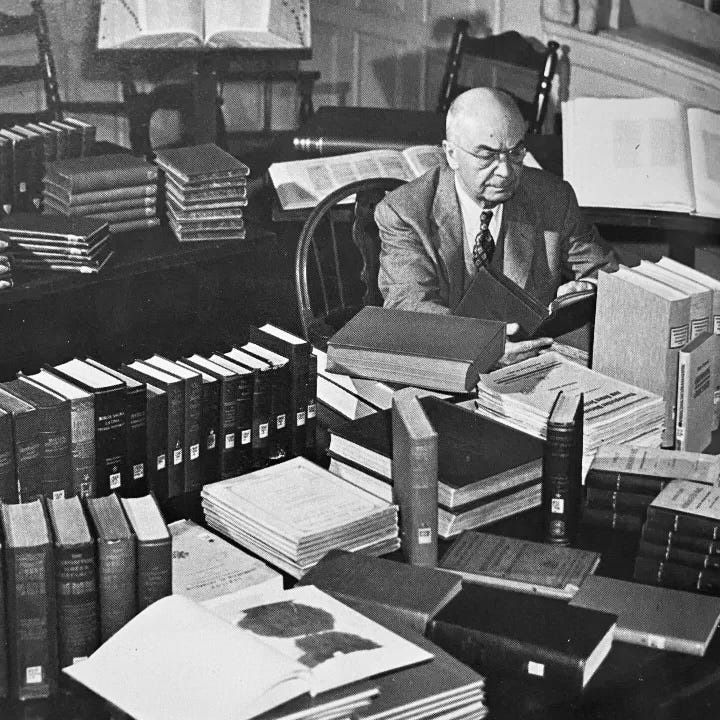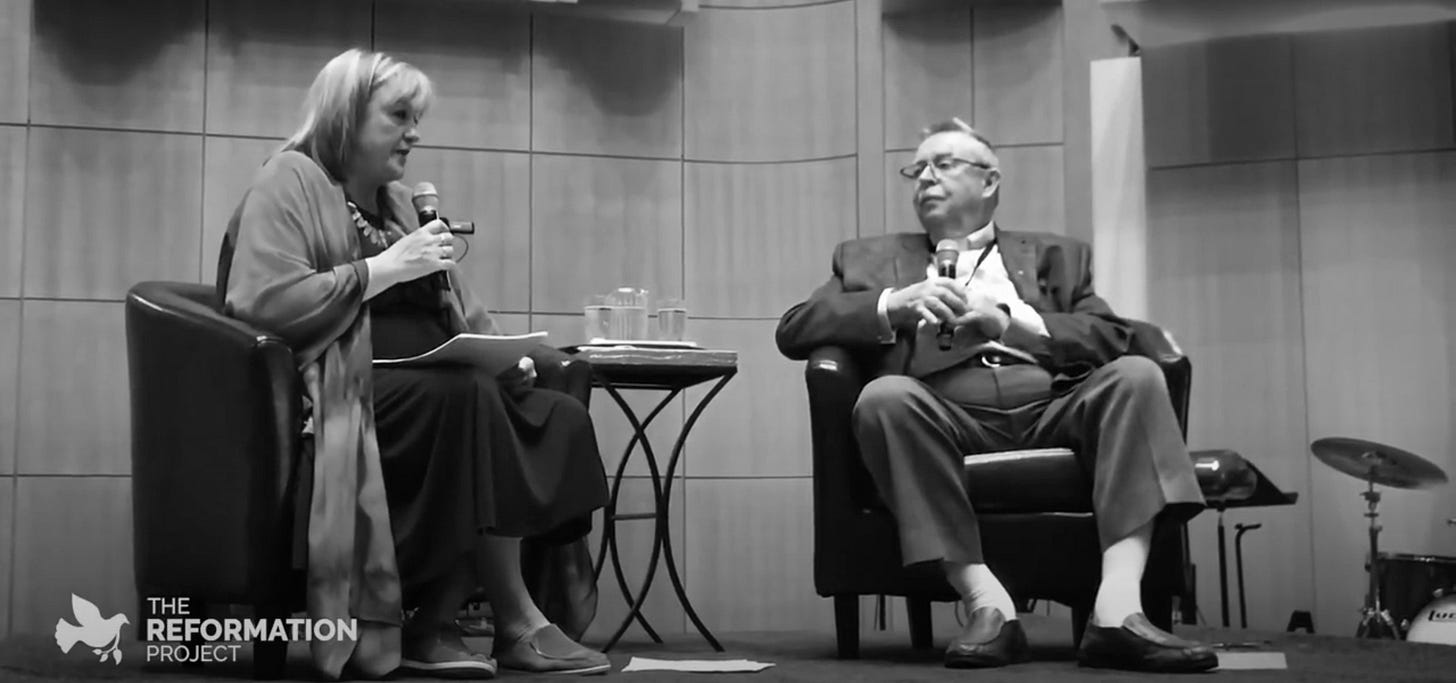The word homosexual never appeared in any translation of the Bible until 1946
How a translational error has cost the lives of millions all over the world
I had just asked a question at Sunday school. I don’t remember the question; I asked many of them. Unlike when baby Jesus asked the Rabbis questions at the temple, I was not met with praise for my brilliance, and this day was no exception. Whatever the question was, it must have been a good one because the Sunday school teacher did not have an adequate response. I know this because I was not given scripture or a theological treatise, as a grade-schooler would certainly and normally expect. Instead, I received a bumper sticker response. You know the kind I mean, a meme before memes, a postcard-level quip designed to shut you up.
“God said it, I believe it, that settles it.”
That was the first time I had ever heard the phrase, but it certainly wouldn’t be the last. As I grew older, I heard variants of this phrase over and over again, including on actual bumper stickers. The basis of this kitschy phrase is rooted in a broader theological problem known as Biblical Inerrancy. It may surprise some of you that the Bible was not always evaluated through such a rigid lens. In many ancient theological circles, the general understanding of the Bible is that it was a mystery meant to be understood as an anthology of books that comprise a text that tells the good, bad, and the ugly of humans attempting to understand the world, politics, governance, law, and their relationship with the divine.
Growing up evangelical, I was taught that the Bible was a book of absolutes, but as I read the scriptures for myself, I didn’t see that. Whereas I was told that God could never be wrong, I found verses where God asks for forgiveness for the evil he intended to do (Exodus 32:14). At church, I would hear sermons about how the devil had been cast out of Heaven and could never stand in the pretense of God; later in life, I read about how Satan walked into the throne room of God to challenge him to a game of craps over the wellbeing of Job (Job 1:6-22). As a young priest, my very first Easter Mass was thrown into upheaval when I was struck with the reality that Jesus was not in the tomb for three days. These ideas of who God is, according to some interpretations, compared to the plain text of the Bible, didn’t seem to match up all that well.
It turned out that within the church of my youth, there were those who believed in a literal six-day creation of the planet and those who ascribed to the idea of the Day-Age Theory. Conversely, when it came to the end of the world, there were those who believed that we would be raptured before the great tribulation, mid-trib, and post-trib. When I asked my father about this, he told me, “There are many ways to understand these things—in the essentials, unity; in non-essentials, liberty; in all things, love.” Even that quote becomes an anecdote of the problem, often attributed to Augustine, but in reality has doubtful authorship. Yet, this quote has also become a bumper sticker phrase used to excuse certain theological problems and not others. It was a dizzying reality in which to grow up. However, there was one theological problem that seemed to have an absolute and was entirely devoid of love: homosexuality.
How did we get here? How did we become a church less concerned about the orphans and widows and hyper-focus on who someone f+cks (or makes love to, if you are into that sort of thing)? It seemed a maddening case of “do as I say, not as I do.” The Bible is literal, except when it is inconvenient to my life, choices, and personal liberty. However, for you and everyone else, the scripture is myopic.
Now, as an adult and theologian, my question to my Sunday school teacher would be, “But what if God didn’t say it, but you still believe it, and now millions have shed their blood over a mistranslation of scripture?”
Unholy Sh+t
1 Corinthians 6:9-11
Pride Month Special Edition
1947: Homosexuality has entered the chat
There are plenty of fascinating Biblical conspiracies that have led to book deals that evolved into movie deals that have become part of the zeitgeist. Did Jesus have a wife? Are there secret codes hidden within the scriptures? Was Solomon’s temple a real and tangible place? Did Moses take magic mushrooms before his interactions with a burning bush? Did he need to take antibiotics afterward? Of all these questions asked of the scriptures and possible mistranslations evaluated by modern scholars, few have had as grave consequences as the events surrounding the release of the Revised Standard Version of the Bible. Up until its publication, most versions of the Bible that existed in English were the King James Version of the scriptures, which is not only a bad translation, but it was initially released in 1611. Thus, its version of English was nearly impossible for modern readers to understand. The National Council of the Churches of Christ in the USA gathered together to create a manuscript with modern language while still playing on the poetry of earlier translations that would be accurate to the original intentions of the scriptures. They released the New Testament in 1946, and it was an instant hit.
Below is an example of a commonly known verse from the Psalms of King David that will help you see how the language was made more contemporary without losing its flow as folks have grown to know it:
Psalm 23:1-3 King James Version
The Lord is my shepherd; I shall not want.
He maketh me lie down in green pastures:
He leadeth me besides still waters
He restoreth my soul.
He leadeth me of righteousness
For his name’s sake.
Psalm 23:1-3 Revised Standard Version
The Lord is my shepherd, I shall not want;
He makes me lie down in green pastures.
He leads me beside still waters;
He restores my soul.
He leads me in paths of righteousness
for his name’s sake.
People went absolutely bonkers for this sh+t. By the time the complete version of the Protestant scriptures was released in 1952, this quickly became the leading translation in the nation. In many ways, it was a revolutionary act. The Revised Standard Version used texts different from those of the King James Version of the Bible to reach their conclusions. One of those texts was a Dead Sea Scroll version of Isaiah, a major controversy at the time. When I tell you that some folks lost their ever-loving minds over this, that is an understatement. Pastors threatened to burn the newly translated scripture (because there is nothing new under the sun), and there were countless protests of this new woke version of the scriptures. Ultimately, this re-branded Bible found an ally in a young pastor by the name of Billy Graham, who believed that a more contemporary language could help others grow to learn more about the life and times of Jesus Christ. As his following began to grow, Billy Graham gave away millions of copies of this particular translation of the scriptures, which were now being read behind pulpits and sitting on the bedside tables of countless Americans.
Then, in 1959, a young seminarian wrote to one of the translators of the Revised Standard Version concerning a possible error. His letter warned that, should an update not be made, he feared that one particular verse would become a “sacred weapon” for extreme literalists. Equipped with his knowledge of the ancient languages, a keen eye for detail, and desire for accuracy, a rigorous discussion began between the young seminarian named David Fearon contacted Dr. Luther Weigle, the committee president who oversaw the translation of the Revised Standard Version. Though Dr. Weigle took Fearon’s concerns seriously and made attempts to update the language in future editions, the damage was already done.


By this point, numerous other English translations were released or in development, which all piggybacked on the work done by the National Council of the Churches of Christ in the USA. Essentially, this error had become a virus that would quickly infect the rest of the world. What was the word that David Fearon was so concerned about, and what consequences did he prophetically see as a problem for future generations?
Homosexual.
Before we dive right into the verses, let's have a quick convention about the epistles. For lack of a better explanation, reading Paul's letters is like skipping the meme and only reading the comments. You might eventually figure out what’s happening, but you only see one part of the story. Paul wrote these letters as responses, and they are being sent to specific church communities under his authority in some way. What we lack in these letters is the original correspondence. Were these questions Paul answered posed orally or by written communication? We don’t always know. The letters are Paul’s attempt to respond to specific conflicts or disagreements from within Christian communities during the infancy of the church. Paul is writing assuming that the people reading will understand the context because they asked for his opinion. We are missing those questions and, therefore, a great deal of context. We are reading the replies, not the original tweet that started the kerfuffle.
Choosing to isolate a verse like 1 Corinthians 6:9-11, the one that concerned Fearon so much, and not contextualizing it is not only bad theology but also irresponsible exegesis.
The word used by Paul in this verse is arsenokoitai. Over time, this word has been translated into short forms like effeminate and homosexual to more long-form versions like “men who have sex with men.” If you haven’t noticed, that’s a massive discrepancy because being effeminate is not necessarily homosexuality, and “men who have sex with men” is a sentence, not just a word, but we have a word. How did we get to this problem?
Because no one knows exactly what the word arsenokoitai means and that is because it doesn’t exist anywhere else in the world—Paul made it up. Like, quite literally pulled it out of his ass and created it. More accurately, it is a composite word. He has taken two words from the Old Testament, or Torah, and smooshed them together to make a whole new word. Some have even argued that it is akin to slang. A direct translation of the word is “man bed.” That’s it. This has left the translators of the scripture the ability to leave it up to wild interpretation because they have nothing else in antiquity to pull from to figure out what is going on. However, later research has helped us discover that there was something deeper going on here and the real reasons why Paul was condemning the actions of what he called arsenokoitai.
The root of the word Paul invented is found in Leviticus 18:22 and 20:13. He attempts to recall the law and the condemnation of “abusers of men.” However, even translating the words into “men” is not an accurate retelling of the events. Many scholars today agree that the real issue here is not men sleeping with men but adult men raping young boys.
In 1 Corinthians 6:9-11 and 1 Timothy 1:9-10, Paul uses the word arsenokoitai to describe the type of sex that he is condemning. The original readers of these letters would have understood the word's connection to the Torah and realized that this was referencing pagan temple sex. Interestingly, Paul does not use his made-up word in Romans 1:25-27; instead, he opts to describe more vividly what he is offended by. He begins in Romans with a lengthy condemnation of humans who abandoned the trueness of God for worshiping idols. He goes into a long rant about how humans have failed to acknowledge or worship God, choosing to worship the likeness of other humans and even animals. He condemns idolatry, and then, right smack dab in the middle of his frustration about what he views as pagan practices, he mentions again the types of sexual practices he sees as abhorrent: forced ritualistic sex.
Sure, I suppose if you lift these verses out of their original context, it sounds like a blanket condemnation of same-sex relationships. However, it's clear to see, if you pull the scope back just a bit, that what he was condemning is his perception of the rituals and practices of other religions: idolatry, animal abuse, sacrifices, and the ritual raping of underage boys by adult men. That is what this whole thing is about, always has been, from Genesis to Leviticus to the later writings of Paul. These verses aren’t targeted at the gay community; they are simply saying, “You don’t have to rape people to get close to God; you can just, I don’t f+cking know, pray or something like a not horrible person.”
These were the very concerns that Fearon brought to Dr. Weigle; if we condemn all homosexuality and not simply the perverse acts of abuse condemned in the scriptures, then we will create a problem of epic proportions. Weigle conceded his error but was unable to make immediate changes to the text due to an agreement with the council and publisher. In 1971, a second edition of the New Testament was released, modifying the language of 1 Corinthians 6:9-11, but the damage had already been done. Some of the newer English translations used the original flawed research that brought the council to the conclusion of translating arsenokoitai to homosexual in one verse of the scriptures. This had horrific results because this led to future translations in other versions of the Bible adding the word homosexual to some or all of the clobber verses regardless of whether their origins were arsenokoitai.
From 1947 to 1971, a span of 24 years, the mistranslation was allowed to move throughout the English-speaking world. Worst of all, some lazy translators used the English manuscripts to translate Bibles into other languages instead of going from the original texts to those languages. This resulted in the word homosexual to be added to these non-English language editions. All previous translations of the scriptures had not used the word homosexual in their interpretations of 1 Corinthians, but it had now become a buzzword within the right wing of Christianity. Figures like Jerry Falwell and John MacArthur began to run with this in light of the Stonewall Riots in June 1969. During that time, though the translators of the Revised Standard Version were aware of the problem and intended to correct it, the word homosexual was still explicitly condemned, for the first time, in the leading translation of the scripture, and no one has publicly contested it yet. When the updated version was finally released in 1971, no public apology, acknowledgment, or retraction of the error was published. Instead, the correction was quietly updated. Since there has never been a recall on the publications since 1947, the egregious mistake continued circulating throughout the world, preached in stadiums, behind pulpits, and at Bible studies. The pervasive lie, albeit made in error, was about to collide with a moment when the Church would be needed the most but would choose instead to abdicate its responsibilities to the marginalized, destitute, and sick.
In 1981, a small group of men became infected with a novel virus. It began popping up in hospitals, and by the mid-80s, a full-blown epidemic was underway. However, the deadly illness was mostly only showing up in three demographics: intravenous drug users, prostitutes, and gay men. This would be a moment for both the government and church to work, as they had in the past, to concern themselves with the wellbeing of the people they are charged with protecting; neither did.
During the 14th century, a plague that would become known as the Black Death ravaged the world. Conservative estimates say this pandemic killed roughly 50 million people, and it is further estimated that about 42% of priests during that period died as a result of the disease because they acted as frontline workers providing medical care, last rites, and funerals to those infected. It has been common practice for the clergy to imbed themselves directly into the middle of a crisis and respond with compassion, even if it is a risk to their own life. Yet, in 1981 the church decided to take an entirely different approach asking a dangerous question based on the principles of eugenics, “Would it really be THAT BAD if the world was rid of heroin addicts, hookers, and homosexuals?”



Instead of running to the frontlines of the crisis, the institutional church huddled up and, now equipped with their newly homophobic Bibles, conflated two scriptures to justify their genocidal actions: Leviticus 20:13 and 1 Corinthians 6:9-1. For centuries, these two verses had been widely interpreted to mean something else other than homosexuality, but now, in the majority of English texts, they say the same word: homosexual. In these new English translations, Leviticus states that the punishment for being gay is death, and Paul condemns these acts in the New Testament in his first letter to the Church in Corinth, saying that homosexuality is still viewed as a sin. Additionally, Paul also stated in his letter to the Church in Rome that “The wages of sin is death (Romans 6:23).” Combining all of these ideas together, the newly formed Moral Majority decided that AIDS was simply a natural consequence for having a nature of sin, and therefore God’s will, so there would be no further action taken. The religion that denied evolution was now relying on a perversion of Darwin’s survival of the fittest. Since Reagan, who was president at the time, was essentially gifted his office by the far-right component of the new Evangelical wave, he got in line lock-step with the murder-by-omission plan of the mainstream Christian leadership of the day.
Reagan did not publicly acknowledge AIDS until the fall of 1985, allowing the virus to move from an isolated incident to a widespread crisis with an estimated global body count of between 33 million and 51 million human beings to date.
After completing the Revised Standard Version of the Bible, the National Council of the Churches of Christ in the USA donated their work, notes, and correspondence to the Sterling Memorial Library at Yale University. That research remained relatively untouched until two unlikely companions began to seek out a long-lost truth: Kathy Baldock and Ed Oxford.
Kathy befriended a gay woman of color by the name of Meadow Montoya while they both daily hiked the same canyon. Though at the time Kathy was still part of the very institutions that had frequently ignored the plight of Montoya’s friends, she did not respond with, “My name is Meadow Montoya, you killed so many of us, prepare to die” or “I want my friends back, you son of a bitch!” Instead, they built a lasting friendship that opened Kathy’s eyes to a pervasive problem within her core belief system. As their friendship grew, Kathy became increasingly frustrated with God about excluding her friends from the love and saving grace she grew up with as a default privilege. Her research led her to discover the translational error made by the Revised Standard Version translators.
This eventually led to her befriend a man named Ed Oxford, a gay man who worked in finance and was also struggling with his sexuality. Together, they began researching the translation errors and eventually discovered the letters between David Fearon and Dr. Weigle. But a pervasive question remained: could David Fearon, the young theologian who raised the alarm through his letters, still be alive today? By this point, he would certainly be in his 80s, but would that be possible?
The answer was yes.
The now Reverend David S. Fearon had come out as gay, pastored a church in Canada, and was still very much alive. Sadly, Reverend Fearon was reposed to the Lord during Pride month, 2023. He was 84 years old. However, he lived long enough to see the fruits of his labor produce not only several books, essays, and reconciliation organizations but also it was the basis of a documentary called 1946 | The Mistranslation that Shifted a Culture.
During my research for this essay, I read numerous counterarguments made by those who oppose the research done by Kathy Baldock, Ed Oxford, and Reverend David S. Fearon. One such blog essentially said, “So we are supposed to throw out thousands of years of tradition because some guys wrote a letter?”
*Paul has entered the chat*
One of the great arrogances of our time is Protestant Christianity forgetting its roots. It makes me think of when Peter Pan forgets who he is in Hook, and we are all collectively Wendy, Toodles, and Tink over here screaming at him to remember while we watch in horror as Captain Hook destroys Neverland. It’s as if they forget that everything Paul wrote was a scandal at the time or that Martin Luther pinning his post to the church door in Wittenberg on Halloween Day of 1517 was an act of defiance against an institution he believed was causing tremendous harm. Yet, so many evangelicals refuse to realize that they are now the very institution in need of a reformation, and the church so desperately yearns for someone like Paul to send a letter to it lest it fall into the trappings it attempted to escape. The very idea of asking a question such as, “So we are supposed to throw out thousands of years of tradition because some guys wrote a letter?” is laughable! As if that is not exactly what the Gospels and the Epistles were doing! The gospels were allegedly written by Jewish men deconstructing their own faith, for better or worse, and yet it's posed as a theological impossibility for anyone to do that now. According to biblical literalists, the letters of Paul are set in stone, regardless of translational errors. Yet, the query of the young David Fearon is nothing more than ink on paper.
I can hear the cries now, “Nathan, are you saying the letters between David and the good doctor are comparable to the letters of Paul?!”
Of course not; that would be absolutely foolish. I am in no way trying to sanctify the correspondence between two academics as if it were scripture. I am simply saying that I am not sure why we are comparing two-thousand-year-old letters between a bishop and his congregants as scripture either. Both incidents are of men, flawed human beings, attempting to better understand the divine; an act of futility, I might add. I do not think either should be held up as equal to the words of Jesus, but I do believe they should held up against the words of Jesus. And, on the subject of homosexuality, Jesus says nothing. Instead, we are told by him to love our neighbor and to care for “the hungry, the thirsty, the foreigner, the naked, the sick, and the prisoner (Matthew 25:44).” A calling that the church abandoned in the 1980s, thanks to a failed translation of the scriptures, that lead to the death of millions around the world.
In other words, Jesus said, “Silence = Death.”
Acknowledgments: a very special thanks to the extensive research of Kathy Baldock and Ed Oxford; you can learn more about their work at the CanyonWalker Connections. You can learn more about this subject by viewing the film 1946 | The Mistranslation that Shifted a Culture, directed by Sharon Roggio. This piece is dedicated to the memory of Reverend David S. Fearon.








Thank you Nathan
As a mother of a transgender in the South, I appreciate this article very much. Thank you.